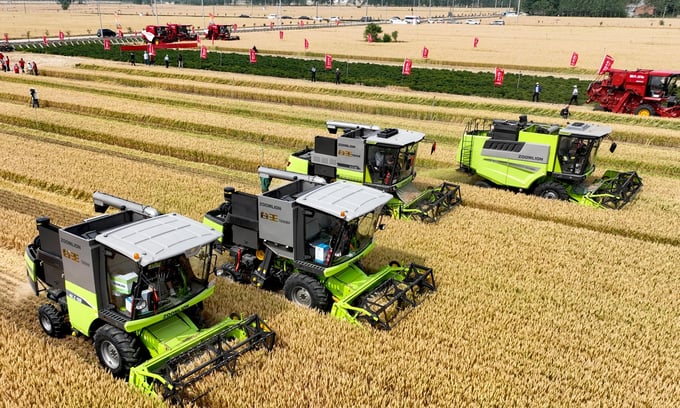June 6, 2025 | 18:27 GMT +7
June 6, 2025 | 18:27 GMT +7
Hotline: 0913.378.918
June 6, 2025 | 18:27 GMT +7
Hotline: 0913.378.918

An agricultural machinery operator drives a harvester at a farm in Bozhou, East China's Anhui Province on May 27, 2022. As Grain in Ear, a traditional Chinese calendar day signaling a proper time for farming, approaches, local farmers have ratcheted up efforts to either plant or harvest summer grain. Photo: VCG
Chinese farmers have started reaping their autumn crops and they're making steady progress now, with little impact seen from the severe drought in major growing areas this summer. Although the heat waves did weigh on crop yields, the overall impact of the drought is limited, farmers and experts said.
So far, 170 million mu (11.33 million hectares) of the autumn crops have been harvested, completing more than 13 percent of the set target, according to the Ministry of Agriculture and Rural Affairs (MOA).
More than half of the autumn crops have been harvested in Southwest China. In the middle and lower reaches of the Yangtze River and southern China, the harvested crops have accounted for approximately 20 percent. In Northeast China and regions along the Yellow River and Huaihe River, harvesting is sporadic so far, according to MOA.
Autumn crops have grown well in most areas despite the summer heat and severe drought, after wide-ranging measures were taken promptly to ensure irrigation, Li Guoxiang, a research fellow at the Chinese Academy of Social Sciences' Rural Development Institute, told the Global Times on Monday.
"The harvest is proceeding smoothly and steadily from the south to the north, and it's in line with the schedule," Li said. A broader harvest is expected to arrive in early October.
Farmers in major producing areas, such as Northeast China and the middle and lower reaches of the Yangtze River, told the Global Times that the drought has had a limited impact on yields, and local governments have been taking active measures to ensure the harvest.
A farmer in Jingzhou, Central China's Hubei Province told the Global Times that the drought had mainly affected early rice, but that the government's efforts to divert water from the Yangtze River had helped the planting of other rice varieties, which will be harvested in mid-October.
Hu Dan, a salesperson in agricultural machinery in the province, said that the local government pumped water into the planting bases day and night at the height of the summer drought season, which ensured the irrigation of 20,000 mu of grain there.
More than 40 percent of the grain and 70 percent of the corn have been harvested in Hubei, and it's been better than expected, with major grain-producing areas on track to produce 40 billion tons of autumn crops, mostly rice, Hubei Television reported on Sunday.
According to the meteorological observatory on Sunday, the drought is expected to affect Central China's Hunan Province, East China's Jiangxi Province, Southwest China's Chongqing and Southwest China's Guizhou Province in the coming days.
Looking forward, the lasting drought will not have a major impact on the yield as they have entered the harvest season, experts said.
"The bulk of the autumn grain harvesting will come late September and early October, and the autumn crop production has basically settled. For harvesting, dry weather is not bad," Jiao Shanwei, editor-in-chief of industry news website cngrain.com, told the Global Times on Monday.
(Global Times)

(VAN) With the war ongoing, many Ukrainian farmers and rural farming families face limited access to their land due to mines and lack the financial resources to purchase needed agricultural inputs.

(VAN) Vikas Rambal has quietly built a $5 billion business empire in manufacturing, property and solar, and catapulted onto the Rich List.

(VAN) Available cropland now at less than five percent, according to latest geospatial assessment from FAO and UNOSAT.

(VAN) Alt Carbon has raised $12 million in a seed round as it plans to scale its carbon dioxide removal work in the South Asian nation.

(VAN) Attempts to bring down the price of the Japanese staple have had little effect amid a cost-of-living crisis.

(VAN) Fourth most important food crop in peril as Latin America and Caribbean suffer from slow-onset climate disaster.

(VAN) Shifting market dynamics and the noise around new legislation has propelled Trouw Nutrition’s research around early life nutrition in poultry. Today, it continues to be a key area of research.